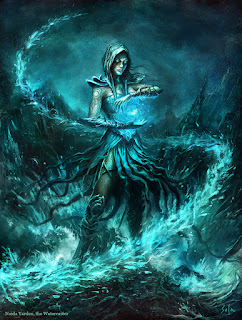Like, really really weird.
They are alien creatures, closer related to humans than to the fish they so resemble. They breath air but live in water. They have a single nostril on top of their heads that they seal off so they don't accidentally kill themselves while going about their daily business. They eat shrimp smaller than any part of their bodies. They sing underwater when they want to mate.
Hang onto your skirts, because whales are a whole lot weirder than that if you add magic into the mix.
But First, an Explanation
Hundreds of thousands of years ago, when the creatures of the world were being created, someone threw a pair of baby seals into an ocean, and that ocean just so happened to be a magical hotspot. Not much is known about exactly what happened to the seals, but suffice to say, it was dramatic, probably explosive, and created whales as we know them.
Continued exposure to the magic over thousands of years has warped whales, particularly whale oil, into a strange, magic-infused mess. Whale oil itself fetches oodles of money (oodles=1000 silver/ton, or 2000-3000 silver per whale).
Whale hunting is a common and dangerous profession. Those who practice it either make their fortune, or die trying.
Typical whale hunting gear involves nets, harpoons, and at least 1 mage.
Whales are bloody weird. Whenever you see a whale, roll on the following table.
What, you thought I would have a post about magic whales
and not include some way for them to fly?
Roll 1d20
- The whale can fly at the same speed it can swim.
- The whale can swim through land. Only land though, buildings will be crushed against it.
- A permanent storm follows the whale, as strong as a hurricane.
- The whale is over three times the size any self-respecting creature has the right to be.
- The whale is godlike is size. Stats: good luck. At this point, you aren't picking a fight with an animal, or even a monster. You're fighting a mountain, or a medium-sized island.
- The whale has a volcano coming out of it's back. The water near the whale is boiling hot, and a dragon lives there.
- The whale operates on a slightly different timeline than everyone else. Every attack against it deals 1d10% of it's maximum health, while any non-damaging effect makes it's hit points 1d100% of it's maximum health (this can make it heal health or take damage). It's attacks are made from paradoxes, and mean that you are both hit and not hit at the same time. The attacks have a 75% chance to deal damage, a 24% chance to heal you, and a 1% chance to instantly heal you.
- Absorbs people into it's body. Any creature it touches fuses with the outside of it's body if they and their nervous systems fuse together. It has 1d4 creatures from your random encounter table already there, and can call on their knowledge
- Smart. The whale has an intelligence comparable to a human.
- Fast. The whale can swim at twice the normal speed, and jump 3x as high.
- Lucky. The whale is being chased by a small army. It hasn't noticed.
- Cult. A cult follows the whale. It has 1d20 barbarians following it around on boats, who will die for it if need be. If it has 1 cultist, the cultist is a very confused fisherman named Billy, who doesn't remember anything. 2 cultists mean Billy is joined by his equally confused wife.
- Acidic. The whale leaks acid into the surrounding water. When it swims it leaves a trail of death behind it.
- Invisible. The whale is invisible. Drinking it's oil will turn your innards and blood permanently invisible, and lamps that burn the oil shed an ambient light with no discernible source. PC's may be able to smear themselves with blood to turn invisible.
- The whale is being ridden by a wizard named Shukila the Mad, who can only cast charm spells.
- The whale is undead. 50% chance of having a necromancer and 2d10 zombies inside.
- The whale is eldritch and alien to look at (it might look a little like a bear).
- The whale is hairy and coloured ice-blue. It turns anyone it touches into ice. Lamps made from it's oil burn cold.
- The whale is nearly indestructible. It has 1,000,000 hit points.
- The whale is Beeooooouuuuuuuaaaaaaaa, the god of whales. He has intelligence as a human, and all normal god abilities.
Populate this with rat-monkies or some shit like that.







